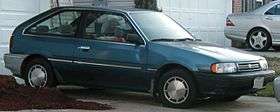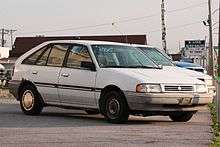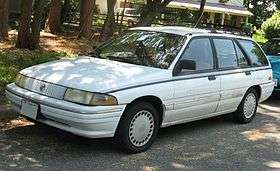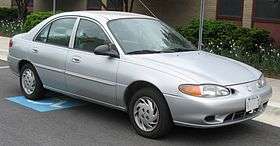Mercury Tracer
| Mercury Tracer | |
|---|---|
 1993–1996 Mercury Tracer 4-door | |
| Overview | |
| Manufacturer |
Mazda (1987–1989) Mercury (Ford) (1990–1999) |
| Production | 1987–1989, 1990–1999 |
| Layout | FF layout |
| Chronology | |
| Predecessor | Mercury Lynx |
| Successor | Ford Focus (Mexico) |
The Mercury Tracer is a compact car that was marketed by Mercury from 1987 for the 1988 model year until 1999. The replacement for the Ford Escort-derived Lynx, the first generation of the Tracer was a modified version of the Asia-Pacific market Ford Laser, itself a variant of the Mazda 323.[1] In 1990 for the 1991 model year, the Tracer became the Mercury counterpart of the Ford Escort in North America.[2] All three generations of the Tracer were based on variations of the Mazda 323/Protegé.
The Ford Focus would serve as a common replacement for both the Ford Escort and the Mercury Tracer.
First generation (1988–1989)
| First generation | |
|---|---|
 | |
| Overview | |
| Also called | Ford Laser (KC) |
| Production | 1987–1989 |
| Model years | 1988–1989 |
| Assembly |
Hermosillo, Mexico[3] Taoyuan City, Taiwan Hiroshima, Japan |
| Body and chassis | |
| Class | Subcompact |
| Body style |
3-door hatchback 5-door hatchback 5-door station wagon |
| Related | Mazda 323 |
| Powertrain | |
| Engine | 1.6 L Mazda B6 I4 |
| Transmission |
5-speed manual 3-speed Mazda F3A automatic |
| Dimensions | |
| Wheelbase | 94.7 in (2,410 mm) |
| Length |
Hatchback: 162.0 in (4,110 mm) Wagon: 169.7 in (4,310 mm) |
| Width | 65.2 in (1,660 mm) |
| Height |
Hatchback: 53.0 in (1,350 mm) Wagon: 53.7 in (1,364 mm) |


The Tracer was introduced in late 1987 as a 1988 model, replacing the Lynx in the United States and Canada. For the first time since the 1978 Capri II, the Mazda 323-based Tracer was a model unique to the Mercury division. Although derived from the Ford Laser sold in Asia and Australia, it was sold without a Ford counterpart in North America. As with its predecessor, the Tracer was sold in three-door and five-door hatchback body styles along with a five-door station wagon. The Tracer hatchback shared its body shell with the Ford Laser; while the station wagon was based loosely on the five-door hatchback, it was a distinct design.
The Mercury Tracer was assembled in a number of production facilities; the location was dependent on the body style and the country to which it was exported. Three-door hatchbacks for the US market were built alongside the Mazda 323 in Hiroshima, Japan, while five-door models were built in Mexico by Hermosillo Stamping & Assembly, where all station wagons were produced. For the Canadian market, both three and five-door hatchback models were built in Taiwan by Ford Lio Ho.[4]
Engine
Second generation (1991–1996)
| Second generation | |
|---|---|
 | |
| Overview | |
| Production | 1990–1996 |
| Model years | 1991–1996 |
| Assembly | Hermosillo, Mexico |
| Body and chassis | |
| Class | Compact |
| Body style |
4-door sedan 5-door station wagon |
| Related |
Ford Escort Mazda 323 Mazda Protegé |
| Powertrain | |
| Engine |
1.9 L CVH I4 1.8 L Mazda BP I4 |
| Transmission |
5-speed M5 manual 4-speed F-4EAT automatic |
| Dimensions | |
| Wheelbase | 98.4 in (2500 mm) |
| Length |
Wagon: 171.3 in (4,351 mm) Sedan: 170.9 in (4,341 mm) |
| Width | 66.7 in (1,690 mm) |
| Height |
Wagon: 52.7 in (1,340 mm) Wagon: 53.6 in (1,361 mm) |
| Curb weight | 2498 lb (1133 kg) |
.jpg)
After skipping the 1990 model year, the Tracer returned in early 1990 as a 1991 model. While again based on the Mazda B platform, it now shared a body with the Ford Escort and the Mazda Protegé. The hatchback models were replaced by a four-door sedan; the five-door station wagon was carried over. The Tracer was sold in three trim levels: GS, LS, and LTS. The LTS was discontinued in 1993.
Changes to the Tracer over this generation were relatively few. In 1992, the plastic grille insert was replaced by the light bar grille seen on the Topaz and Sable. In 1993, a driver's side airbag replaced the automatic seatbelts; in 1994, a passenger airbag was added, bringing a redesigned dashboard with it.
The Tracer LTS (which used the more powerful 1.8L Mazda engine shared with the Escort LX-E and Escort GT) was named to Car and Driver magazine's Ten Best list for 1991.
Engines
- 1.9 L (1,859 cc) CVH I4, 88 hp (66 kW) 108 ft·lbf (146 N·m)
- 1.8 L (1,839 cc) BP I4, 127 hp (95 kW) 114 ft·lbf (154 N·m) LTS
Trim levels
Sedan
- base • 1991–1996 model years
- LTS • 1991–1994 model years
Wagon
- base • 1991–1996 model years
Third generation (1997–1999)
| Third generation | |
|---|---|
 | |
| Overview | |
| Production | 1996–1999 |
| Model years | 1997–1999 |
| Assembly | Wayne, Michigan |
| Body and chassis | |
| Body style |
4-door sedan 5-door station wagon |
| Related |
Ford Escort Mazda Protegé |
| Powertrain | |
| Engine | 2.0 L SPI 2000 I4 |
| Transmission |
5-speed IB5 manual 4-speed F-4EAT automatic |
| Dimensions | |
| Wheelbase | 98.4 in (2,500 mm) |
| Length |
Wagon: 172.7 in (4,387 mm) Sedan: 174.7 in (4,440 mm) |
| Width | 67.0 in (1,700 mm) |
| Height |
Sedan: 53.3 in (1,350 mm) Wagon: 53.9 in (1,369 mm) |

The Tracer and Escort were updated in 1996 for year model 1997 with a redesigned exterior and interior, and a new engine. The platform remained the same as before.
The Tracer wagon largely retained the same body style, gaining only the new interior, front end & fascia, side-view mirrors, door handles, badging, and slightly restyled taillamps and reflectors.
In addition to GS and LS trims, there was also a Trio appearance package offered from model year 1997 until 1999 on the GS. The LS trim featured tachometers and alloy wheels along with optional leather interior, key-less entry and power windows and door locks.
All Tracer models were discontinued in 1999 along with the Escort wagon. Mercury sold 23,146[5] Tracers in its last model year. The final Mercury Tracer rolled off the assembly line on July 2, 1999.
Trim levels
Sedan
- GS • 1997–1999 model years
- LS • 1997–1999 model years
Wagon
- LS • 1997–1999 model years
Engines
Proposed 2011 revival
Early in 2010, the Tracer nameplate nearly made its return to the Mercury model lineup. As Ford confirmed its 2012 model line with dealers, the Mercury model line was expanded with an all-new compact sedan slotted below the mid-size Milan.[6] Reviving the Tracer nameplate for the first time in 13 years, the new sedan would be based on the 2012 Ford Focus, giving the Mercury division a version of the Focus for the first time.
However, in the summer of 2010, the Mercury division was phased out, leaving the proposed Tracer to be cancelled.
References
| Wikimedia Commons has media related to Mercury Tracer. |
- ↑ International Motor Business, Issues 137-140, Economist Intelligence Unit, 1989, page 54
- ↑ The Global Strategies of Multinational Enterprises and Government Policies: Ford Motor Company and the Automobile Industry in Canada and Mexico, Volume 2, Isabel Studer-Noguez, 1997, page 340
- ↑ Machine that Changed the World, James P. Womack, Daniel T. Jones, Daniel Roos, Massachusetts Institute of Technology, Simon and Schuster, 1990, page 265
- ↑ Trade Opportunities in Taiwan, Volume 15, Issues 1-26, Far East Trade Services, Incorporated, 1987, page 19
- ↑ "Ford Motor Company Sets New Full Year U.S. Sales Record". Theautochannel.com. Retrieved 2009-04-28.
- ↑ "worldcarfans.com|New Ford Focus Badged as Mercury Tracer Due in 2011".
| « previous — Mercury passenger vehicle timeline, 1980–2011 | |||||||||||||||||||||||||||||||||
|---|---|---|---|---|---|---|---|---|---|---|---|---|---|---|---|---|---|---|---|---|---|---|---|---|---|---|---|---|---|---|---|---|---|
| Type | 1980s | 1990s | 2000s | 2010s | |||||||||||||||||||||||||||||
| 0 | 1 | 2 | 3 | 4 | 5 | 6 | 7 | 8 | 9 | 0 | 1 | 2 | 3 | 4 | 5 | 6 | 7 | 8 | 9 | 0 | 1 | 2 | 3 | 4 | 5 | 6 | 7 | 8 | 9 | 0 | 1 | ||
| Coupe | |||||||||||||||||||||||||||||||||
| Sport compact | Capri | Capri | Cougar | ||||||||||||||||||||||||||||||
| LN7 | |||||||||||||||||||||||||||||||||
| Personal luxury | Cougar | Cougar | Cougar | ||||||||||||||||||||||||||||||
| Sedan | Subcompact | Bobcat | Lynx | Tracer | |||||||||||||||||||||||||||||
| Compact | Tracer | Tracer | |||||||||||||||||||||||||||||||
| Zephyr | Topaz | Topaz | Mystique | ||||||||||||||||||||||||||||||
| Monarch | |||||||||||||||||||||||||||||||||
| Mid-size | Cougar | Marquis | Sable | Sable | Sable | Sable | Milan | ||||||||||||||||||||||||||
| Full-size | Marquis | Marauder | Montego | Sable | |||||||||||||||||||||||||||||
| Grand Marquis | Grand Marquis | Grand Marquis | Grand Marquis | ||||||||||||||||||||||||||||||
| Station Wagon | Subcompact | Bobcat | Lynx | Tracer | |||||||||||||||||||||||||||||
| Compact | Zephyr | Tracer | Tracer | ||||||||||||||||||||||||||||||
| Mid-size | Cougar | Marquis | Sable | Sable | Sable | Sable | |||||||||||||||||||||||||||
| Full-size | Colony Park | ||||||||||||||||||||||||||||||||
| Light truck | |||||||||||||||||||||||||||||||||
| SUV | Mariner | Mariner | |||||||||||||||||||||||||||||||
| Mountaineer | Mountaineer | Mountaineer | |||||||||||||||||||||||||||||||
| Minivan | Villager | Villager | Monterey | ||||||||||||||||||||||||||||||